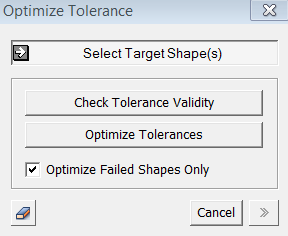Repair: Optimize Tolerance

Function
Optimize Tolerance adjusts the Tolerances of improperly defined shapes.
Call
Geometry > Repair > Optimize Tolerance

<Optimize Tolerance>
Select Target Shape(s)
Select
Target Shapes for which Tolerances need to be adjusted.
Check Tolerance Validity
Check
to see if the Tolerances of the shapes are proper. The
check result is produced in Output Window.
Optimize Tolerance
Adjust the Tolerances of the shapes.
Optimize Only Failed Shape Only
Optimize the Tolerances of only the shapes, which were found to be improper in the Tolerance check.
Notes
All shapes retain internal Tolerances, which the program automatically calculates and assigns. Sometimes, improper Tolerances can be assigned to very small shapes, which can lead to problems. Such improper Tolerance information may also come from a Geometry Data File, especially when an IGES file is imported (STEP file format is recommended.) Improper Tolerances cause improper Boolean Operations and abnormalities in other operations such as Divide Face, Divide Solid, etc.
Computation time for an Optimize Tolerance operation can be excessive depending on the complexity of a model. It is recommended that the working file be saved prior to executing the command.
The following functions are based on Boolean Operation.
Curve
> Intersect
Surface > Fuse, Divide by Curve, Divide by Surface ,Trim by Curve, Trim
2 Surfaces, Imprint
Solid > Divide, Trim, Embed
Boolean > Fuse, Cut, Common
Modifier Feature >Local Prism